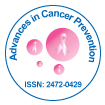Cancer, a Multigenic Disease Requires Nature Derived Multi-targeted Drugs
Received: 28-Jun-2016 / Accepted Date: 20-Sep-2016 / Published Date: 26-Sep-2016 DOI: 10.4172/2472-0429.1000118
127372Multi-targeted Drugs
Cancer is a term characterized by the uncontrolled growth and spread of cells leading to invasion of normal tissues. Cancer develops due to the changes caused to normal cells to acquire abnormal functions. Inherited mutations or environmental factors like, X-rays, chemicals, ultraviolet light, etc are the changes that lead to cancer. So, these facts suggest that cancer is not a result of a single factor. It typically, takes many years to elapse for normal cells to evolve into cancerous cells [1]. In 2012, according to the WHO, the global cancer burden accounted for 14.1 million new cases and 8.2 million deaths. According to epidemiological data, the incidence and due to cancer is much higher in developed countries than the developing ones [2].
Extensive research, have revealed that dysregulation of not a single gene but multiple genes leads to cancer. Investigation of the genomic landscape has revealed that there are only limited numbers of genetic alterations leading to most types of cancers [3]. For example, in smallcell lung cancer 163 mutations were found while 8 were found in acute amyloid leukemia [1]. Since out of all the genes mutated in a cancer, the driver genes are responsible for the oncogenesis while the passenger genes are not relevant [3]. Hence, it is very important to understand the role of the genes whose alterations accumulate in cancer progression and of those genes whose laterations play crucial roles in the metastatic potential. The isolation of first tumor suppressor gene, ie., RB, from the human genome [4] lead to the discovery of more than 20 tumor suppressor genes. Their molecular analyses have led to the fact that more than one genes are responsible for the tumor progression [5,6]. These analyses also indicated that these alterations occur in a stepwise manner during the complete progression and also that more mutations were found in the later stage tumors than in the early stage ones [1]. In the evolution, through the process of tumor progression, the gatekeeper mutation provides a selective growth advantage to the epithelial cell to outgrow the surrounding cells [6-8]. These mutations, conferring the selective growth advantage, are the driver mutations [9].
Knowing that cancer is a hyper proliferative disorder, being regulated by various growth factors, a large number of small-molecule inhibitors (in the form of drugs) have been developed to block their signaling [1]. Some of the examples are, EGF, VEGF, PDGF and IGF-1. Imatinib has been approved for the treatment of chronic myeloid leukemia, gastrointestinal stromal tumors and B-cell chronic lymphocytic leukemia, as it targets BCR-ABL. Most of the targeted therapies provide very little benefits. Most appropriate example is of Herceptin, which is an antibody raised against HER2 and is extremely successful. But still, only 20% of women expressing HER2 respond to Herceptin but in a year they develop resistance to it [10]. The current available reports state that these targeted therapies provide marginal benefits and are highly expensive too [11]. Along with this, the targeted therapies depict a lot of side effects too like, hair loss, fever, nausea, fatigue, vomiting and diarrhea.
On the other hand, the agents isolated from natural sources have been reported to have multi-targeting properties. According to the facts presented by Newman and Cragg, about 74.8% drugs approved by US FDA are derived from natural sources [12]. In the older times, no targets were known when vincristine and vinblastine were used and found to be effective [13]. Even in the Hindu epic, Ramayana, there is a mention of arsenic pastes for the treatment of cancerous growths [14]. Since natural products can interact with multiple targets hence they can treat a number of illnesses like diabetes, cardiovascular and autoimmune diseases [15]. Conclusively, we can say that the molecular targets from the natural products have a large opportunity for the development of modern drugs [15]. Since many traditional remedies have proven their worth in the past we need to rethink and consider untargeted or multi-targeted therapies over the present day targeted therapies.
References
- Hasima N, Aggarwal BB (2014) Targeting proteasomal pathways by dietary curcumin for cancer prevention and treatment. Curr Med Chem 21: 1583-1594.
Citation: Singh S (2016) Cancer, a Multigenic Disease Requires Nature Derived Multi-targeted Drugs. Adv Cancer Prev 1: 118. DOI: 10.4172/2472-0429.1000118
Copyright: © 2016 Singh S. This is an open-access article distributed under the terms of the Creative Commons Attribution License, which permits unrestricted use, distribution, and reproduction in any medium, provided the original author and source are credited.
Select your language of interest to view the total content in your interested language
Share This Article
Recommended Journals
Open 91جزة« Journals
Article Tools
Article Usage
- Total views: 11873
- [From(publication date): 11-2016 - Aug 02, 2025]
- Breakdown by view type
- HTML page views: 10943
- PDF downloads: 930
